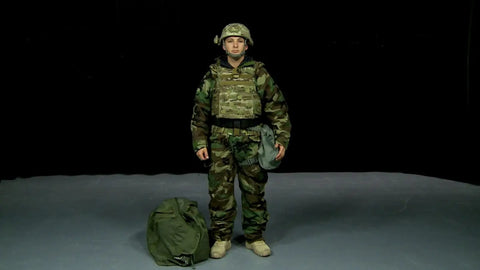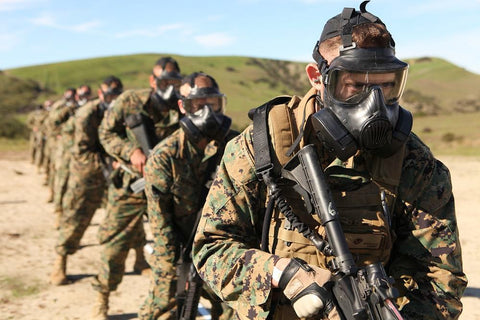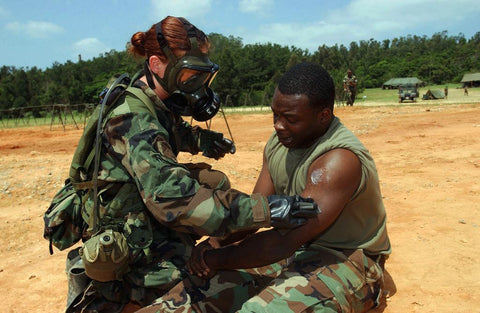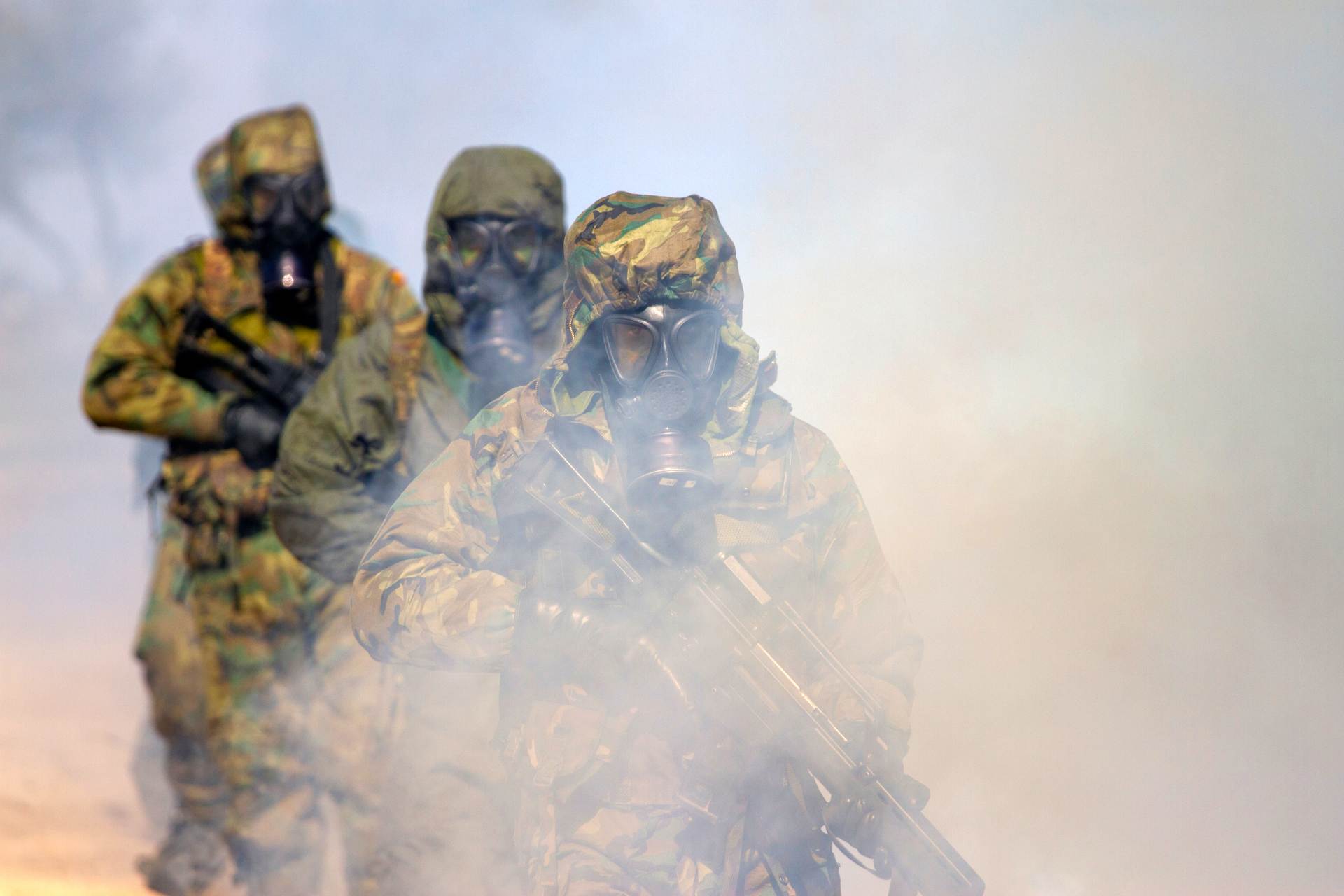Humanity has been developing technologies to defend the home front for hundreds of years, resulting in the highest number of enemy casualties.
The strategies military leaders employ to instill terror in the minds of their deadly opponents change with time. One such classic threat is the possibility of a chemical attack, which can occur instantly and kill anybody in its path.
Although most of the world community now despises chemical strikes, they were used on the front lines of World War I, and they are still a threat. U.S. forces are more trained than ever to defend themselves from potential threats by employing specialized equipment.
Mission Oriented Protective Posture (MOPP) gear is provided to safeguard our men from chemical, biological, radiological, and even nuclear attacks.
What is MOPP?

With MOPP, missions can be completed more efficiently by providing adaptable chemical agent protection.
MOPP is a catch-all term that can refer (usually speaking) to the current protective posture required, to the usage of MOPP gear in general, and occasionally even to the gear itself.
The first fact is the presence or absence of NBC threats. Equipment and adoption depend on whether NBC threats exist. Are protective postures necessary? This equipment and its use are meant to protect against NBC threats.
If not, why not? In the face of NBC threats, commanders must deal with these issues.
The majority learn this during basic training, where they are instructed on how to quickly wear MOPP gear, which includes protective coveralls, gloves, overboots, a hood, and a gas mask.
Some trainees endure the sensation of wearing all that gear and being escorted into a tear gas-filled "gas chamber." No raw recruit is quite prepared for inhaling tear gas. Thus, any face mask with a poor seal or protective equipment worn poorly will be visible in this scenario.
In other training scenarios, you are compelled to take off your mask and give your complete name before being permitted to run outdoors to escape the effects of the tear gas.
The MOPP Gear
MOPP ensemble is another name for MOPP gear. The apparatus consists of an overgarment, overboots, gloves, a gas mask, and a hood to protect the wearer from nuclear, chemical, or bacterial agents.
In the past, layers of activated charcoal were used to manufacture MOPP overgarments to offer the garment's protective function. The outdated activated charcoal suits, which leave a noticeable black and powdery residue after use, have given way to more lightweight carbon beads and more practical clothing designs.
The gas mask's replaceable air filters must be changed regularly, and the whole thing must be decontaminated after field use. Specialized field-operational decon methods are available for individuals wearing MOPP gear during drills or events.
When to wear MOPP Gear?
MOPP gear and the measurement of MOPP levels are required in various situations. Most modern service members encounter this during basic training, first duty assignment, and deployment.
Although U.S. troops haven't been directly targeted by nuclear, chemical, or biological weapons in most American wars in the twenty-first century, this doesn't indicate that these weapons haven't been employed.
The civil war in Syria is an outstanding illustration of this. In 2019, National Public Radio (NPR) reminded us that during the civil war, "Syrian President Bashar Assad's regime carried out 98 percent" of all chemical assaults, "...dropping chlorine gas, sarin and sulfur mustard gas on Syrian civilians."
As seen above, chemical warfare is still a top concern when defending soldiers on the battlefield.
It's never a good idea to presume that the enemy will follow the Geneva Conventions, international law, or other laws when combating terrorists, rogue states, or other situations. The Geneva Protocol forbids "asphyxiating, poisonous or other gases, and of all analogous liquids, materials or devices" and "bacteriological methods of warfare."
However, it is never safe to assume that such warfare won't occur on the battlefield or as part of a terror campaign only because it constitutes a war crime.
MOPP Limitations
- Heat Exhaustion—People wearing protective gear who work hard may become heat-exhausted at any time, but it is most common during hot weather.
- Work Rate - The total quantity of work a person can perform will be impacted by respiratory resistance, a rise in body temperature, and psychological and physical stress.
- Five Senses- The senses and linked abilities, including motor skills, the ability to see clearly, and vocal communication, will function less effectively.
- Personal Needs- People cannot maintain complete chemical protection for extended periods while caring for their personal needs, such as wound care, personal hygiene, sleep, and waste removal.
- Eating—It is impossible to eat while wearing a gas mask. However, depending on the type and level of contamination, troops may be able to eat in an NBC environment.
The Five MOPP Protection Levels
The MOPP levels are reminiscent of the post-9/11 threat situation levels used in the initial months after the 9/11 attacks.
The MOPP level ranges from 0 to 4. Soldiers must constantly be ready since they are based on current chemical and biological threats and can escalate in minutes.
Standardized MOPP levels make it simple for commanders to boost or lower security. Commanders don't need to give detailed explanations when ordering greater or lower protection because the levels are uniform, and all soldiers know them.
Soldiers first put on the MOPP gear components that take the longest to put on and have the least negative impact on mission performance. They then put on the MOPP gear components that can be swiftly put on and have the biggest negative impact on mission performance.
This adaptability gives soldiers an advantage while donning their MOPP gear.
The rest of the equipment needed to protect the troops includes overgarments, gas masks and hoods, boot covers, and gloves.
MOPP ZERO
- Carry a protective mask, and ensure that individual protective gear is within arm's reach.

When operating in a situation where an opponent can launch an NBC attack, or even just the capacity to do so, MOPP Zero is not a sign that "no threat at all" exists. Instead, it refers to the minimal level of awareness that is necessary.
In addition to having the MOPP equipment close at hand (in the work area, vehicle, combat position, or a similar location), soldiers carry a protective mask with LCE.
When the enemy can use NBCs, but chemical warfare has not started, or when forces are first sent outside the theater of operations, MOPP zero is appropriate.
Thanks to MOPP zero, soldiers do not have to wear overgarments or masks, but can still access them when needed.
The battle dress overgarment should be tightly closed in the vapor-barrier bag until needed. The soldiers carry the M258A1 decontamination kit, M8/M9 detector paper, and NAAK.
MOPP1
- Suit worn. Mask, gloves, and boots are carried.

With this threat, soldiers wear only the protective overgarment; the remainder of the outfit should be carried or maintained nearby for quick access.
In hot weather, it can be worn directly over their underwear. The jacket can be left open for air, but the pants must be closed. They put on the protective helmet cover and fastened the M9 paper to the overgarment.
The reaction time needed for soldiers in MOPP1 to adopt MOPP4 protection against an attack has been reduced from 8 minutes to 4.
This level of risk denotes that while there is no immediate threat to the troops, an attack could occur at any time or when contamination is nearby.
MOPP2
- A suit and boots are worn. Gloves and a mask were carried.

MOPP 2 is essentially worn under "yellow alert" circumstances—"alarm yellow" is a typical identifier—where the overgarment and overboots are worn—a protective posture that presumptively anticipates the necessity for the remaining protective gear to be necessary without notice.
Once troops are in MOPP2, they can quickly transition to higher MOPP levels by putting on the overboots, which take around three to four minutes. Soldiers can leave their overgarment jackets open in hot weather for ventilation, but they must maintain safety.
Although MOPP 2 doesn't always mean that an assault is about to happen, individuals wearing it will find it much simpler to put on and wear the remainder of their equipment should the situation worsen.
MOPP3
- Suit, boots, and mask worn. Gloves carried.

In MOPP3, soldiers wear protective masks and hoods—except for gloves—nearly completing the level of protection. This level may pose a vapor hazard, contact contamination, or other risks.
However, this causes severe work-related interference. The mask and hood limit vision, heat stress increases, and there is a higher danger of heat exhaustion. Soldiers in hot weather may pull up the protective mask hood and open the overgarment jacket for ventilation, but they must keep their trousers fastened.
MOPP4
- All protection is worn.

Lastly, MOPP level 4 is by far the most terrifying.
In this protective posture, the entire MOPP ensemble must wear overgarments, overboots, masks, hoods, and gloves.
Personnel close their overgarments, tighten all drawstrings to prevent gaps, wear protective gloves, and enclose themselves. When the maximum level of protection is required or when CB agents are present but the actual danger cannot be identified, MOPP4 is employed.
Soldiers wear NBC rubber gloves with cotton liners to protect their hands. They finish the protection by pulling the hood down, adjusting it, and closing the overgarment.
Like previous MOPP levels, the system's design incorporates flexibility to relieve the individual. Once the danger has been identified and preventative measures taken, the overgarment may be left open.
MOPP4 has the most detrimental influence on a person's efficacy and efficiency.
Mask-Only Posture
Soldiers shielded from direct skin contact with liquid or solid contamination (transfer hazards) do not have to wear protective overgarments or rubber gloves when working in a polluted area.
Tanks, vans, and structures are examples of this type of partial shielding against contamination. Soldiers may be exposed to vapor dangers but not transfer hazards inside these shelters.
For instance, a teletype operator in a sealed communications van can work safely and much more effectively while wearing a mask.

-
The value of a mask-only posture's enhanced efficiency must be weighed against its increased risk. Soldiers within the shelter may be exposed to a transfer hazard if weapons, fire, or an accident breach it. When a shelter is breached, regular clothing offers temporary transfer risk protection.
-
Before leaving their bunker, soldiers in mask-only posture must assume the proper MOPP level. Returning soldiers must carefully avoid introducing liquid contamination inside the shelter to preserve a mask-only posture. The mask-only command is appropriate in the following circumstances:
- There haven't been any chemical attacks, and the troops outside are at MOPP3 or MOPP4.
- The unit is in a downwind vapor-hazard area with troops outside MOPP4.
- There has been an attack, and nonpersistent vapor is the only danger.
The choice to switch to mask-only for soldiers shielded from liquid-agent contact ultimately rests with the commander. The command "mask only" is inappropriate when blister-agent dangers are present.
System Flexibility
The MOPP system is versatile and adaptable. Flexibility is the secret to offering the best protection with the least risk while enabling mission completion.
Flexible MOPP protection enables subordinate commanders to change the amount needed for combat success in specific circumstances.
Additionally, commanders can assign all or a portion of their units to multiple MOPP levels or approve changes within a single level.

a. Taking ownership of MOPP Levels.
Corps must direct minimum MOPP levels, and higher-level commanders must also recommend greater MOPP levels proportional to the threat.
These commanders are informed about any strategic or tactical intelligence pointing to the potential employment of NBC weapons. Their primary duty is to improve the unit's defensive posture.
Division and subordinate commanders are responsible for issuing orders for MOPP2 through MOPP4.
However, the company commander, platoon leader, or squad leader has the final say. At this level, what the unit can and cannot do is clearer.
Based on situational analysis and instructions from higher command, the leader decides whether to tighten or loosen the unit's defensive posture.
This level of final accountability keeps the system's flexibility. The leader below the established minimum level cannot lower the defensive posture level.
b. changes to the MOPP levels.
Each MOPP level is highly flexible, allowing for changes depending on the circumstances. Certain modifications to MOPP gear wear prevent unit efficiency decline.
Commanders must consider these variances regarding the potential for contamination and mission success. They should make these choices immediately to alter MOPP. The following list recommends some changes.
-
At MOPP1, MOPP2, or MOPP3, soldiers may leave their overgarment jackets open to improve ventilation. At MOPP3, they may also leave their hoods up or down. The threat, temperature, and unit work rate affect the commander's decision to deploy this variant.
-
The overgarment can be worn directly over underwear or the battle dress uniform (BDU). The temperature and the staff's productivity are deciding variables.
-
Soldiers must wear safety gloves when handling decontaminated equipment at MOPP1 through MOPP3. This prevents contact with substances that might adhere to the equipment's surface.
-
The commander may change the MOPP levels when the mission is critically important, and residual nuclear effects pose the only threat. The commander's primary concern is gamma radiation, which MOPP gear cannot shield against, as was previously mentioned. The commander may opt to change the unit's posture if it is found that there is only a low-level residual radioactive threat due to mission requirements. This will decrease the unit's heat stress-related performance deterioration.
-
Risks include beta particle burns and alpha particle ingestion. As showers are no longer a part of the decontamination process, another issue is the bigger one of eliminating radioactive particles from the hairy parts of the body. Soldiers may, as a last resort, use the M258A1 kit's wet wipes for this usage. Although neither circumstance significantly reduces the unit's performance, both must be considered.
-
One way to change the protective posture is to have the soldiers use the cloth liners that come with their butyl gloves. This covers as much exposed skin as possible. Instead of using protective masks, soldiers might cover their mouths with handkerchiefs or other dust-proof materials.
The primary considerations are reducing skin contact with radioactive contamination and avoiding the intake of radioactive particles. Soldiers who can complete the operation while wearing their full MOPP gear will lessen the risk of beta burns and alpha particle ingestion. They will not need additional decontamination procedures.






















































